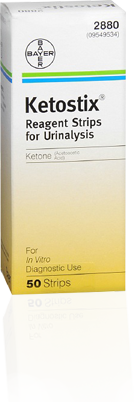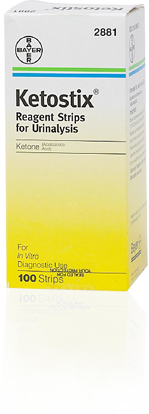Ketostix
Urine Test for Ketone (Acetoacetic Acid)
- The strips provide a fast, convenient way of testing urine for the presence and concentration of acetoacetic acid (ketone). This substance when found in the urine provides information on carbohydrate and fat metabolism.
- Acetoacetic acid can be found in the urine from diabetics and is more commonly referred to as a “ketone body.” Use of Ketostix Reagent Strips can alert you and your doctor or diabetes educator to changes in your condition for which adjustments in your diet and/or medication may be needed. Carefully follow the testing schedule your doctor or educator establishes.
Reagents: 7.1% w/w Sodium Nitroprusside; 92.9% w/w Buffer Intended for use in the U.S.A. Reagent made in U.S.A. Questions? Toll Free 1-800-347-8100
| Indications |
| KETOSTIX Reagent Strips are for in vitro diagnostic use. They have been determined to be nonhazardous under the guidelines issued by OSHA in 29CFR 1910.1200(d).As with all laboratory tests, definitive diagnostic or therapeutic decisions should not be based on any single result or method. KETOSTIX results should never be used as the sole basis for adjusting insulin dosage. |
| Warnings |
|
Definitions
Ketoacidosis (Acidosis): What happens in the body when not enough insulin is available. Blood sugar is usually high at this time. Moderate or large ketones are present in the urine as well as in the body.
Ketostix: Strips for measuring urine ketones (acetone). They are also available as Ketodiastix (for urine ketones and sugar).
Ketones (Acetone): The chemicals that appear when not enough insulin is present and fat is broken down. Acetest tablets, Ketostix or Chemstrip K measure urine ketones. The Precision Xtra measures blood beta ketones.
mg/dl: Milligrams of material in a measured amount (100cc). Blood sugar (glucose) levels are expressed in these terms in the U.S., but they are usually expressed as mmol/L in Europe. It is possible to convert mg/dl to mmol/L by dividing by 18 (or multiplying by 0.0555). The opposite is done to go from mmol/L to mg/dl.
mmol/L: Method of measuring the amount of a material (sugar or ketones) in the blood. This method is usually used in Europe.
Void: Passage of urine
read moreKetostix and diabetes
Ketones are chemicals which appear in the urine and blood when body fat is used for energy. Ketones are a side product of fat breakdown Body fat is used for energy…
- when there is not enough insulin to allow sugar to be burned as energy in the body.
- when not enough food has been eaten to provide energy.
Ketone testing is VERY important. A method of testing for ketones must be kept in the home (and taken on trips) at all times. Doctors teach families how to do the urine ketone teston the first day of diagnosis of diabetes. Frequent urine ketone tests are important in the first few days after diagnosis to determine if enough insulin is being given to turn off ketone production. Turning off ketone production is the first goal in the treatment of newly diagnosed diabetes managed in the outpatient setting. This usually takes one or two days after starting insulin. The second goal is to lower blood sugar levels (done primarily by turning off internal sugar production in the liver). This usually takes one or two weeks after starting insulin. Giving insulin helps to accomplish both goals.
Reasons for testing for ketones It is important to test for urine or blood ketones because they can build up in the body. This can result in one of the two emergencies of diabetes, acidosis or ketoacidosis. In the past, it was only possible to test for urine ketones. The Precision Xtra™ meter is now available to do a home fingerstick test for blood ketones. The diabetes care provider should be notified when the urine ketone test shows moderate or large ketones or if the blood ketone test is above 1.0 mmol/L. Usually extra insulin is taken to help make the ketones go away. If the ketones are not detected early, they will build up in the body and ketoacidosis will result. This is particularly true during illnesses. Early detection of ketones and the treatment with extra rapid-acting insulin (Humalog/NovoLog/Apidra) can help prevent hospitalizations for ketoacidosis. Hospitalizations for ketoacidosis are still listed as the number one reason for hospitalizing children in the U.S. with known diabetes. It is our belief that these hospitalizations for ketoacidosis are completely preventable. To accomplish this, the ketone testing must be done, the diabetes care provider called when indicated, and extra shots of insulin given.
When to test for ketones Ketones must always be checked if the blood sugar is high (above 240 mg/dl [13.3 mmol/L] fasting, or above 300 mg/dl [16.7 mmol/L]) during the day. They must also be checked ANYTIME THE PERSON FEELS SICK OR NAUSEATED (especially if he/she vomits, even once). If the person is sick, ketones can be present even when the blood sugar is not high. CALL YOUR DIABETES CARE PROVIDER NIGHT OR DAY IF MODERATE OR LARGE URINE KETONES ARE PRESENT OR FOR BLOOD KETONES = 1.0 MMOL/L. TELL THE PERSON ANSWERING THE PHONE THAT THE CALL IS URGENT. People who have been recently diagnosed with diabetes usually need to check ketones twice daily (or more often if they are positive). After the first few days, if all ketone checks have been negative, daily testing of ketones is not needed. People who take only one insulin injection per day should do routine morning blood or urine ketone tests to see if their insulin is lasting a full 24 hours. Morning ketones will usually be present if an insulin injection is needed in the evening. Testing for urine ketones The Ketostix (or Ketodiastix with the sugar check) is reliable for urine testing IF THEY ARE CAREFULLY TIMED WITH A SECOND HAND ON A CLOCK. The Ketostix are cheaper than the Ketodiastix and it is not necessary to do the urine sugar, as a blood sugar is more accurate. There is a place on the side of the bottle to write the date the bottle is opened. The strips are then good for six months. Individually foil-wrapped Ketostix will not expire for two or three years. This gets around the problem of having to throw any unused Ketostix away once the bottle has been open for six months. Ask your pharmacist to order them if he/she does not have them. The Bayer product number for ordering is 2640 (20 foiled strips).
The following procedure must be followed exactly:
- Completely cover the colored square on the end of the strip by dipping into FRESH urine. Then immediately remove the strip from the urine. We prefer that the urine be collected in a cup and that the strip then be timed and read by two people. This prevents errors due to color blindness or psychologic factors. A supply of small paper cups might be kept in the bathroom medicine cabinet for this purpose.
- Gently tap the edge of the strip against the side of the urine container to remove excess urine.
- Compare the test area closely with the corresponding color chart. The timing is very important. READ KETONES AT EXACTLY 15 SECONDS AFTER DIPPING THE STRIP. HOLD THE STRIP CLOSE TO THE COLOR BLOCK AND MATCH THE COLORS CAREFULLY. These tests must always be timed with the second hand of a clock. Counting is NOT accurate enough.
- Immediately record the result of the ketone test as negative, small (15), moderate (40), large (80) or large-large (160) in the notebook so that it is not forgotten.



